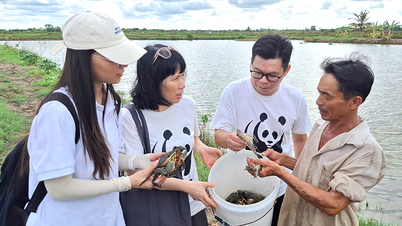I remember in the late 1970s, when I left my hometown to go to Saigon to study at university, my friends who grew up in urban areas and freshwater gardens could not imagine the shape of this strange animal, so they “assigned” me to bring a few to the dormitory for them to “see for themselves”… When I had the chance, I raised my voice as a “teacher of life”: Hey, see, we call it Ba Khia because on its shell (Southern people call it Mu) there are three lines, not because it weighs 150 grams but the scale we used counted just… Ba Khia (at that time, scales were still quite popular, on the scale, each crab was 50 grams)!
The three-striped crab is a crustacean belonging to the crab family, an amphibian, usually making burrows very deep in the water, but all day long they lurk at the mouth of the burrow, occasionally darting out to find food, then quickly retreating into hiding. The three-striped crab usually lives in pairs, and the male with large claws, a large body, and an aggressive body always stays outside as a reliable support for the slender, weak female next to him. Normally, the person who catches the three-striped crab carries a bamboo basket on his shoulder, and in his hand, holds a piece of wood about three or four centimeters wide, suddenly and strongly pulling the burrow mouth, making the big guy unable to retreat and having to run out. Often before he can catch them, they have already slipped into the mouth of the burrow next door. Hunting like that requires a strong hand and quick eyes, but at best it only makes the soup sweet, not to mention that if he accidentally gets pinched, the next day's work is a game.
Yet, every year, during the high tide from July to October of the lunar calendar, from nowhere, swarms of three-sided crabs gather to cover certain mangrove and fish sauce roots... along the coast of the provinces of the Southwest. At first, only the male three-sided crabs quickly arrived first, occupying the "prime" positions, their eight claws clinging tightly to the tree branches, their two large claws sticking out as if in defiance, their mouths continuously blowing overlapping rings of saliva and emitting light, windy sounds. Hearing that call, the female three-sided crabs flocked back, enjoying the festival. As the night grew late, the water rose to its peak, and those mangrove and fish sauce roots were surrounded by three-sided crabs, pairs entwined together.
Strangely, although the density is very high, there is no fighting or competition between the normally aggressive male crabs. Occasionally, some of them are so engrossed in having fun that they let go and fall into the sea, but not long after, they find a way to scramble back up and continue the fun. It is said that although the crabs usually live in pairs, they are not necessarily mates, and that mating to maintain and develop the species only takes place during that exciting festival every year.
After the bustling festival days, each pair of crabs returns to their burrows, preparing for the reproduction process. During this time, the female crabs burrow deep into the burrow, doing only one thing: eating and drinking to store energy to hold eggs and give birth. Everything else, from struggling to find food to fighting to ensure safety, is taken care of by the male crab. The baby crabs only appear when they are strong enough to endure and overcome the harsh challenges of nature, gradually moving out to dig their own burrows, living the lives of adult individuals.
Of course, the crab festival day also becomes a festival for crab hunters.
Waiting until it was completely dark, when the pairs of crabs were busy entwining themselves in dense density, dozens of three-leaf boats gently rowed from the hamlet, weaving their way under the mangrove and fish sauce trees. On each boat was a pond roof filled with about a third of salt water with enough salinity to make the crabs faint.
Due to their amphibious nature, the crabs cannot survive long in overly salty water, so their bodies become limp and they have no strength to defend themselves. The coastal farmers cannot answer how much salt is in these pools, they do it based on their experience, and each region is different. In Ca Mau , people mix salt and drop in a piece of fish sauce, and when the fish sauce floats, it is done; in Tra Vinh, the fish sauce is replaced by a handful of cold rice… Once the boat is fixed, under the light of a lantern (later replaced by a flashlight worn on the forehead), the man stands at the bow, holding a skewer in one hand, reaching up to a branch of the mangrove and the fish sauce to push the crabs into the skewer, then passes it to the woman to pour into the pool. Later, people improved it further by using pieces of wood about three or four inches wide as a “slide”, one end resting on a tree branch, the other end fixed to the mouth of the salt water pool in the middle of the boat. Two people stood on either side of the “slide”, and thus drove each group of three-sided crabs into the roof. When the roof was half-full and the boat was almost full, they turned back home, with enough salted three-sided crabs to last until the next three-sided crab season. Hunting this way always ensured a large quantity and rarely got pinched by three-sided crabs (probably because of the fun they forgot to fight), the product was also very clean from the outside (unlike catching in caves) to the inside, no processing was required.
The crabs brought home are left in the pond overnight to die. After that, they are taken out and neatly arranged in small jars (if they are kept for home consumption) or in plastic bags inside a leaf basket (for transport to the market or wholesale for convenience). On each layer of crabs is a layer of salt in the appropriate proportion, less salty if eaten in a short time and saltier if left for a long time or transported far away. After being salted, the crab meat will lose its saltiness and shrink in the shell, the shell will shrink even more, so when eating, just put it in your mouth and close it (like holding a straw) and suck lightly. The meat stays but the shell is discarded. "Hựt rung" means the meat has been sufficiently fermented, "hựt rung yet" means it is not ready to eat, continue to salt. The person making salted crabs tests by holding the salted crab, breaking a little bit off the tail, if the meat runs along, the crab has "hựt rung" and is ready to eat.
Just a few weeks after the festival, the salted crabs were transported by train and bus to all the markets near and far. At that time, salted crabs were a cheap food for the poor, so they had no market value. Every harvest day, the whole family would work in the fields, sometimes hiring or “working together” in the form of “today I work for you for a few days, then another day you pay me back exactly the same amount”. There were many people and everyone had a great appetite, the landlady was tired from cooking rice, and as for food, there were jars of salted crabs and jars of fish sauce that could be changed. The salted crabs were usually washed, shredded, mixed with sugar to reduce the saltiness, and when eaten, lemon juice, garlic, chili, and chopped raw vegetables were added to reduce the fishy smell. That was all, but we, the young men from the fields, ate bowl after bowl of rice.
Back then, few people thought of making dishes from fresh crabs because this animal mainly eats microorganisms from mud, from humus from fallen leaves of mangrove forests, so its meat and roe are black, not as eye-catching as sea crabs, field crabs, etc. which are quite abundant. When it comes to crabs, people almost only know about… salted crabs.
Recently, perhaps at first, due to the large number of farmers and immigrants to big cities, most of them were poor laborers who brought salted crab with them to their meals to save money and save a little to send back to their hometowns to support their children and parents. Gradually, following their trend, the rustic dishes of the past gradually became specialties in the city, favored by the middle and upper classes. Salted crab "upgraded" and entered the market, even in luxury supermarkets, in a pre-processed way, packaged in boxes of about a hundred grams. Housewives can buy it and put it in the refrigerator to eat gradually. Before each meal, just take out the salted crab, squeeze in some lemon or sliced sour star fruit, minced pineapple... Salted crab water prepared this way, with a plate of boiled sweet potato shoots or cucumber with raw vegetables, even the most fastidious people will find it hard to criticize.
In life, as a rule, when the price goes up, the quantity goes down. If the price of three-sided crab was as it is now, no one in the coastal provinces of the Southwest would be poor in the past. Nowadays, like many other natural aquatic species, the number of three-sided crab has seriously decreased (and we have not heard of any locality experimenting with raising three-sided crab, although sea crabs, field crabs, etc. have all been successfully raised). Three-sided crabs have not gathered together for many decades to attend the festival, although occasionally a few couples choose to climb the branches of the mangrove or fish sauce in the evening to chat...
TRAN DUNG
Source




























































































Comment (0)